4.4
Application to concrete examples
The
graphs in figs. 4.1a, 4.2a and 4.3a show operations
involved in individual cultivation cycles. In each
case the amount of energy introduced into the system
by the use of mechanical and chemical production
is shown. The values also indicate the exposure
of workers to the abovementioned risk factors. Thus
for mechanical operations the higher the energy
input into the system the more work is performed
both in terms of time and power used. This is only
partly true for chemical operations where it is
the type of substance, to which the worker is exposed,
that is of greater importance.
Fig. 4.1a . Cultivation cycle
of wheat. Agricultural techniques and evaluation,
in terms of energy, of the related risk factors.
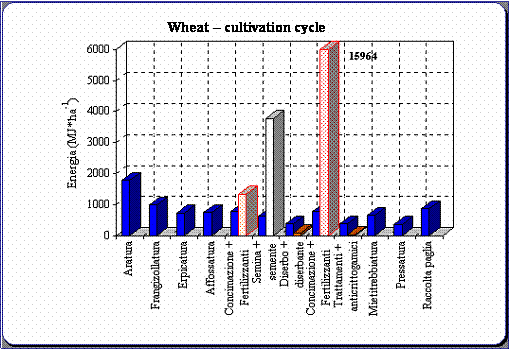
|
LEGEND
|
|
|
|
|
|
|
|
|
|
|
|
|
|
|
|
|
|
|
|
|
|
|
Operations
with exposure to mechanical risks
|
|
|
|
|
|
|
|
|
|
|
|
|
|
|
|
Operations
with high exposure to chemical risks
|
|
|
|
|
|
|
|
|
|
|
|
|
|
|
|
Operations
with moderate exposure to chemical risks
|
|
|
|
|
|
|
|
|
|
|
|
|
|
|
Operations
with negligible exposure to chemical risks
|
|
|
|
|
|
|
|
|
|
|
|
Ploughing
Disc
harrowing
Harrowing
Ditching
Manure
spreading and fertilisers
Sowing
and seeds
Weed
control and herbicides
Manure
spreading and fertilisers
Treatment
and fungicide spraying
Combine
harvesting
Baling
Collecting
bales
Fig.
4.1b Cultivation cycle of wheat. Calculation
of energy input
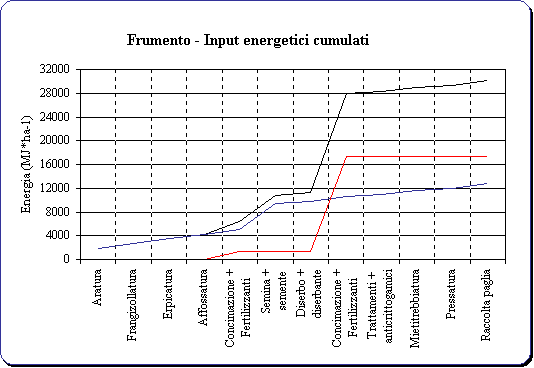
|
LEGEND
|
|
|
|
|
|
|
|
|
|
|
|
|
|
|
|
|
|
Total combined
energy input
|
|
|
|
|
|
|
|
|
|
|
|
|
|
Total combined
chemical input
|
|
|
|
|
|
|
|
|
|
|
|
|
|
Total combined
chemical input
|
|
|
|
|
|
|
|
|
Ploughing
Disc
harrowing
Harrowing
Ditching
Manure
spreading and fertilisers
Sowing
and seeds
Weed
control and herbicides
Manure
spreading and fertilisers
Treatment
and fungicide spraying
Combine
harvesting
Baling
Collecting
bales
Fig. 4.2a . Cultivation cycle
of sugar beet. Agricultural techniques and evaluation,
in terms of energy, of the related risk factors.
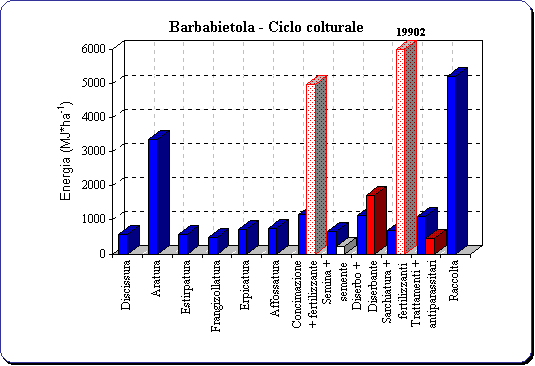
ASSE orizontale
Asse verticale: Energy
Chiselling
Ploughing
Grubbing
Disc
harrowing
Harrowing
Ditching
Manure
spreading and fertilising
Sowing
Sowing
and herbicides spraying
Herbicide
spraying and hoeing
Fertilising
and spraying of plant protection products
Harvesting
|
LEGEND
|
|
|
|
|
|
|
|
|
|
|
|
|
|
|
|
|
|
|
|
|
|
|
|
|
Operations
with exposure to mechanical risks
|
|
|
|
|
|
|
|
|
|
|
|
|
|
|
|
|
|
Operations
with high exposure to chemical risks
|
|
|
|
|
|
|
|
|
|
|
|
|
|
|
|
|
|
Operations
with moderate exposure to chemical risks
|
|
|
|
|
|
|
|
|
|
|
|
|
|
|
|
Operations
with negligible exposure to chemical risks
|
|
|
|
|
|
|
|
|
|
|
|
|
|
4.2b - Cultivation
cycle of sugar beet. Evaluation of the energy inputs
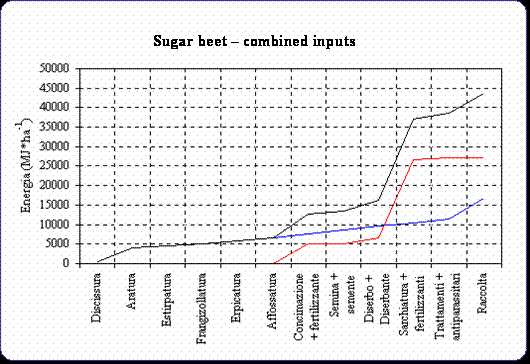
ASSE
orizontale
Asse verticale: Energy
Chiselling
Ploughing
Grubbing
Disc
harrowing
Harrowing
Ditching
Manure
spreading and fertilising
Sowing
Sowing
and herbicides spraying
Herbicide
spraying and hoeing
Fertilising
and spraying of plant protection products
Harvesting
|
LEGEND
|
|
|
|
|
|
|
|
|
|
|
|
|
|
|
|
|
|
Total combined energy input
|
|
|
|
|
|
|
|
|
|
|
|
|
|
Total combined chemical input
|
|
|
|
|
|
|
|
|
|
|
|
|
|
Total combined chemical input
|
|
|
|
|
|
|
|
|
Fig. 4.3a - Cultivation cycle
of sunflowers. Agricultural techniques and evaluation,
in terms of energy, of the related risk factors.
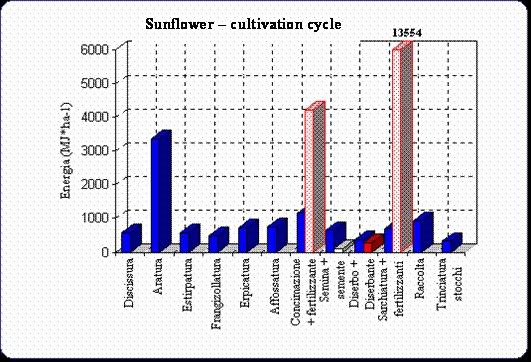
ASSE orizontale
Asse verticale: Energy
Chiselling
Ploughing
Grubbing
Disc
harrowing
Harrowing
Ditching
Manure
spreading and Fertilising
Sowing
and seeds
Weed
control and herbicides
Hoeing
and Fertilisers
Harvesting
Stalk
shredding
|
LEGEND
|
|
|
|
|
|
|
|
|
|
|
|
|
|
|
|
|
|
|
|
|
|
|
Operations
with exposure to mechanical risks
|
|
|
|
|
|
|
|
|
|
|
|
|
|
|
|
Operations
with high exposure to chemical risks
|
|
|
|
|
|
|
|
|
|
|
|
|
|
|
|
Operations
with moderate exposure to chemical risks
|
|
|
|
|
|
|
|
|
|
|
|
|
|
|
Operations
with negligible exposure to chemical risks
|
4.3b - Cultivation
cycle of Sunflowers. Evaluation of the energy inputs
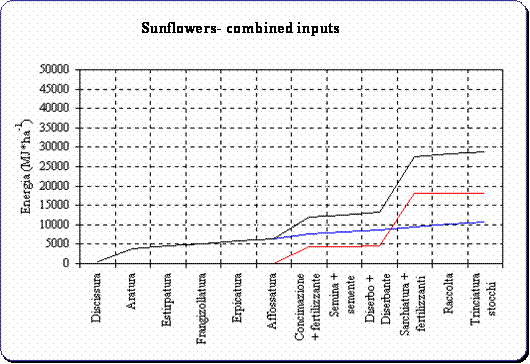
Chiselling
Ploughing
Grubbing
Disc
harrowing
Harrowing
Ditching
Manure
spreading and Fertilising
Sowing
and seeds
Weed
control and herbicides
Hoeing
and Fertilisers
Harvesting
Stalk
shredding
|
LEGEND
|
|
|
|
|
|
|
|
|
|
|
|
|
|
|
|
|
|
Total combined energy input
|
|
|
|
|
|
|
|
|
|
|
|
|
|
Total combined chemical input
|
|
|
|
|
|
|
|
|
|
|
|
|
|
Total combined chemical input
|
|
|
|
|
|
|
|
|
Thus
it would be useful to differentiate operations on
the basis of the toxicity of chemicals used. In
our case, for example, fertilising has been distinguished
from herbicide, insecticide and fungicide spraying.
By
applying this method to real-life situations we
obtain a picture of the succession of operations
during which workers are exposed to various risk
factors with an estimate of related intensity. As
can be seen from graphs Fig. 4.1b, 4.2b and 4.3b,
we also have an evaluation of the environmental
impact of the three cultivation systems under examination,
expressed in energy input totals.
The
next graph shows the period for each operation,
Fig. 4.4.
Fig. 4.4
This
graph shows the times when one is exposed to risk
factors over a farming year. It also provides information
which can be used as the basis for carrying out
tests on the effects of farming on people, the environment
and foodstuffs.
The
method is easy to apply as it involves a study period
during which information pertaining to each cropping
system is translated into energy values. This information
is used to design a program to monitor specific
situations. All this is easily adaptable to different
cropping systems and sectors of agricultural production.
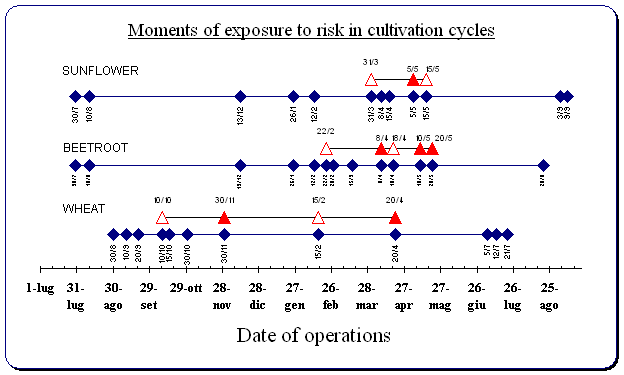
|
Fig. 4.4 - Chronogram of the interventions that
involve mechanical risk (blue rhombus), high
chemical risk (red triangle) and moderate
chemical risk (white triangle).
|
|
|
4.5
Health checks and environmental testing
The
study of problems relating to agro-chemicals focuses
on finding out the real quantities distributed on
the land and defining processes to rationalise their
use. This also extends to workers’ skills.
Laws governing the production of agro-chemicals
safeguard people’s health and the environmental
by using complex testing methods for safety. This
is particularly so when new molecules are introduced.
Indeed environmental toxicological testing takes
up the largest portion of producers’ resources.
Previous